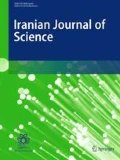Abstract
Different medicinal plants were screened for l-asparaginase. Asparagus racemosus exhibited highest activity (10.11 ± 0.12 U/ml) and specific activity (22.78 ± 0.28 U/mg of protein). A. racemosus was collected from Padmapuram garden of Araku valley, Visakhapatnam district. l-asparaginase activity was detected from the extracts of leaves and rhizome. Enzyme activity was maximum in the extract of rhizome (9.58 ± 0.12 U/ml) with specific activity (21.73 ± 0.28 U/mg of protein) compared with leaves which have the enzyme activity (1.85 ± 0.06 U/ml) with specific activity (2.68 ± 0.14 U/mg of protein). Optimum conditions for the extraction and assay of l-asparaginase from plant rhizomes were studied. Results showed maximum activity of l-asparaginase when the sample to buffer ratio was 3:6, sample weight (g)/buffer volume (ml) using 0.02 M of potassium phosphate buffer solution pH 8.2 at 40 °C. The l-asparaginase activity was 16.01 ± 0.06 U/ml with specific activity (26.81 ± 0.42 U/mg of protein) under optimum conditions.

Similar content being viewed by others
References
Abdel Hameed AM (2005)’Production and Characterization of l-asparaginase from local isolate of Serratia marcescens bacteria’. In: Dissertation, College of Science, Baghdad University, Iraq
Ajila CM, Rao LJ, Rao UP (2010) Characterization of bioactive compounds from raw and ripe Mangifera indica L. peel extracts. Food Chem Toxicol 48:3406–3411
Bano Mozeena, Sivaramakrishnan VM (1980) Preparation and properties of l-asparaginase from green chillies (Capsicum annum L.). J Biosci 2:291–297
Bansal S, Gnaneswari D, Mishra P, Kundu B (2010) Structural stability and functional analysis of l-asparaginase from Pyrococcus furiosus. Biochemistry (Mosc) 75(3):375–381
Borek D, Jaskolski M (2001) Sequence analysis of enzymes with asparaginase activity. Acta Biochim Pol 48:893–902 (no. 4/2001)
Broome JD (1961) Evidence that the l-asparaginase activity of guinea pig serum is responsible for its antilymphoma effects. Nat Lond 191:1114–1115
Chibnall AC (1939) Protein metabolism in plants. Yale University Press, New Haven
Clementi A (1922) La desamidation enzymatique de l’asparagine chez les differentes especes animals et la signification physiologique de sa presence dans l’organisme(Asparginase in vivo in Merschnicinchen serum). Arch Intern Physiol 19:369–398
Copeland RA (2000) Enzymes in antiquity. Practical introduction to structure, mechanism and data analysis Enzymes, 2nd edn. John Wiley-VCH, New York
Hosamani R, Kaliwal BB (2011) Isolation, molecular identification and optimization of fermentation parameters for the production of l-asparaginase, an anticancer agent by Fusarium equiseti. Int J Microbiol Res 3:108–193
Kidd J (1953) Regression of transplanted lymphomas induced in vivo by means of normal guinea pig serum. I. Course of transplanted cancers of various kinds in mice and rats given guinea pig serum, horse serum or rabbit serum. J Exp Med 98:565–582
Lees EM, Blackeney AB (1970) The distribution of asparaginase activity in legumes. Biochim Biophys Acta (BBA) Gen Subject 215:145–151
Lough TJ, Reddington BD, Grant MR, Hill DF, Reynolds PH, Farnden KJ (1992) The isolation and characterization of a cDNA clone encoding l-asparaginase from developing seeds of Lupin (Lupinus arboreus). Plant Molec Biol 19:391–399
Lowry OH, Rosebrough NJ, Farr AL, Randall RJ (1951) Protein measurement with Folin phenol reagent. J Biol che 193:265–275
Majeed AMD (2011) Extraction, purification and characterization of l-asparaginase from Withania somnifera ripe fruits. In: Ph. D thesis, Department of Biotechnology, College of Science, University of Baghdad, Iraq
Manning GB, Campbell LL (1957) The asparagine deaminase of Bacillus coagulans and Bacillus strearothermophilus. Can J Microbiol 3:1001–1009
Michalska K, Jaskolski M (2006) Structural aspects of l-asparaginases, their friends relations. Acta Biochim Pol 53(4):627–640
NPGS/GRIN (1799) “Asparagus racemosus information from NPGS/GRIN (National Plant Germ plasm System/Germ plasm Information Network)” USDA.Sp. pl. 2(1):152. August 6, 2002. Retrieved April 25, 2009
Oza VP, Parmar PP, Kumar S, Subramanian RB (2010) Anti cancer Properties of highly purified l-asparaginase from Withania somnifera L. against Acute Lymphoblastic Leukemia. Appl Biochem Biotechnol 160:1833–1840
Peter MPJ, Raj JY, Sicis VP, Joy V, Saravanan J, Sakthivel S (2012) GC-MS analysis of bioactive components on the leaves extract of Stylosanthes fruticosa—a potential folklore medicinal plant. Asian J Plant Sci Res 2:243–253
Sarker SD, Nahar L (2012) An introduction to natural products isolation. Nat Prod Isol Methods Mol Biol 864:1–25
Sieciechowicz KA, Joy KW, Ireland RJ (1988) The metabolism of asparagine in plants. Phytochemistry 27:663–671
Sodek L, Lea PJ, Miflin BJ (1980) Distribution and Properties of a potassium-dependent asparaginase isolated from developing seeds of Pisum sativum and other plants. J Plant Physiol 65:22–26
Stecher AL, Morgantetti P, De Deus I, Polikarpov LA (1999) Stability of l-asparaginase: an enzyme used in leukemia treatment. J Pharm Acta Helv 74(1):1–9
Velmurugan P, Kamaraj M, Prema D (2010) Phytochemical constituents of Cadaba trifoliata Roxb. root exctract. Int J Phytomed 2:379–874
Verma N, Kumar K, Kaur G, Anand S (2007) l-Asparaginase: a promising chemotherapeutic agent. Critical Rev Biotechnol 27:45–62
Warangkar SC, Khobragade CN (2010) Purification, characterization and effect of thiol compounds on activity of the Erwinia carotovora l-asparaginase. Enz Res 1:1–10
Author information
Authors and Affiliations
Corresponding author
Rights and permissions
About this article
Cite this article
Beulah, K., Hemalatha, K.P.J. Screening of Medicinal Plants for Potential Source of l-Asparaginase and Optimization of Conditions for Maximum Extraction and Assay of l-Asparaginase from Asparagus racemosus. Iran J Sci Technol Trans Sci 43, 1–6 (2019). https://doi.org/10.1007/s40995-017-0359-x
Received:
Accepted:
Published:
Issue Date:
DOI: https://doi.org/10.1007/s40995-017-0359-x




